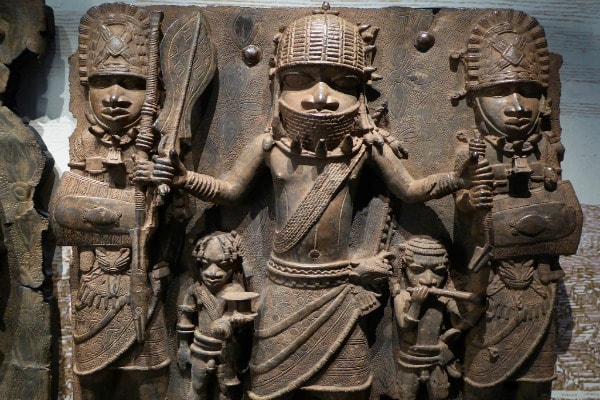About The Benin Bronzes
Benin Bronzes: The year 1897 marked a dark chapter in the history of the Benin Empire, a vibrant pre-colonial nation situated in what is currently known as Southern Nigeria. This once-thriving empire fell victim to a brutal invasion by British forces, resulting in the ruthless destruction of the empire, the tragic loss of thousands of lives, and the systematic eradication of one of ancient Africa’s wealthiest and most culturally significant civilizations. The invading troops left a trail of devastation, burning down the empire and plundering its treasures, including the renowned bronze and ivory artefacts that meticulously chronicled the kingdom’s rich history and traditions.
At the height of the pillaging, the revered king of the Benin Empire was compelled to flee his homeland, seeking refuge from the relentless onslaught of the British troops. Meanwhile, the magnificent royal palace, once a symbol of power and grandeur, was mercilessly looted of its invaluable treasures. Among the most prized possessions of the empire were the iconic Benin Bronzes – a collection of intricately crafted plaques and sculptures numbering in the thousands. These masterpieces of artistry and heritage found their way into the collections of museums across Europe and America, perpetuating the legacy of Benin’s cultural heritage on foreign soil.
Amidst the shadows of this tragic history, a glimmer of hope emerged in 2014, when a notable act of restitution took place. British citizen, Dr. Mark Walker, made headlines by returning two of the iconic Benin Bronzes, namely the Ahianwen-Oro artworks, to their rightful homeland. This act of goodwill sparked a renewed call for the repatriation of numerous artefacts scattered across the globe, echoing the sentiments of justice and the restoration of historical heritage.
Dr. Mark Walker’s poignant gesture carried profound significance, as he revealed that the artworks had been passed down to him by his great-grandfather, an individual who took part in the looting of Benin during the tragic events of 1897. This personal connection underscored the complex legacy of colonial plunder and the enduring quest for redemption and reconciliation.
The repatriation of the Ahianwen-Oro artworks serves as a poignant reminder of the ongoing debate surrounding cultural repatriation, restitution, and the ethical considerations of retaining artefacts acquired through colonial exploitation. It underscores the critical need to address historical injustices and honor the cultural heritage of nations that have long been deprived of their artistic treasures.
As calls for repatriation reverberate across international forums, the story of the Benin Bronzes stands as a testament to the resilience of a nation, the power of restitution, and the enduring quest for justice and reconciliation in the realm of cultural heritage. The tale of the Benin Empire’s loss and the symbolic return of the Ahianwen-Oro artworks encapsulates a timeless narrative of redemption, healing, and the restoration of historical narratives long silenced by the echoes of colonial conquest.


